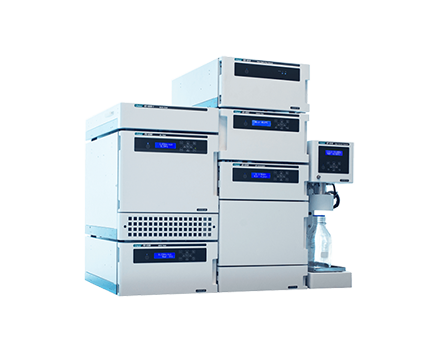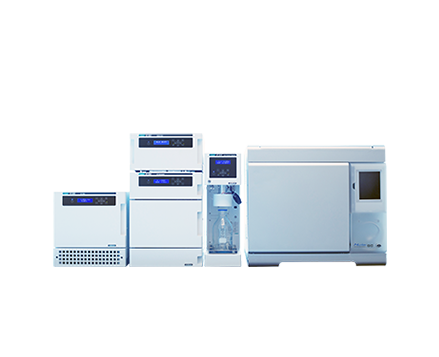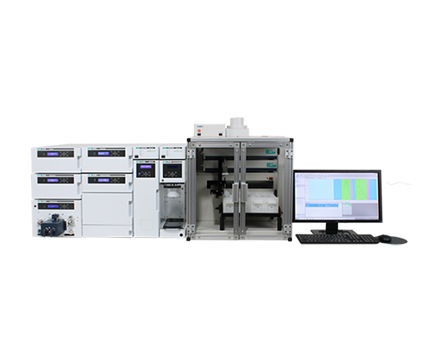ASTM D5186 – Determination of Non-Aromatic and Aromatic Hydrocarbon in Diesel Fuels by SFC
August 25, 2022
Introduction
Application for the analysis of ASTM D5186 – Determination of Non-Aromatic and Aromatic Hydrocarbon in Diesel Fuels by SFC
This application note provides a brief overview of the analysis if diesel fuel to ASTM D5186. Diesel is a complex mixture of hydrocarbons including non-aromatic, mono-aromatic and polyaromatic hydrocarbons. It is well known that the composition of these compounds is closely related to the cetane number of the fuel, the cetane number is increased as the concentration of non-aromatics increases. As the cetane number decreases the amount of particulate matter in exhaust gas increases as the concentration of aromatics increases. The analysis of diesel fuel plays an important role in both the automobile and fuel industries.
ASTM published the Standard Test Method for Determination of the Aromatic Content and Polynuclear Aromatic Content of Diesel Fuels and Aviation Turbine Fuels By Supercritical Fluid Chromatography (D 5186 03) using a Flame Ionization Detector (FID) in 2003. This application note demonstrates that SFC with supercritical CO2 can determine the non-aromatic and aromatic contents in commercially available diesel fuel in accordance with the ASTM D5186 method.
Experimental

The SFC system we used consisted of a JASCO model PU-2080-CO2 Supercritical CO2 delivery pump, a GC-4000 Gas chromatograph with an FID (GL Science), JASCO’s CO-2060 Column oven, a BP-2080 automatic back-pressure regulator, and a JASCO AS-2059-SF autosampler with a Chromatography Data System controlling and data processing data from all of above modules. The SFCpak SIL PA column (5 µm silica gel, 4.6 mm I.D. x 250 mmL) was used for the sample separation. The column effluent was split upstream of the back-pressure regulator and a certain amount of the fluid was introduced into the FID as shown in Figure 1.

1 = bottle of liquefied carbon dioxide, 2 = pump, 3 = autosampler, 4 = heating coil, 5 = column, 6 = column oven, 7 = preheating coil, 8 = splitter, 9 = FID, 10 = oven for GC, 11 = cooling coil, 12 = back-pressure regulator.
Keywords
ASTM D5186, SFC FID, SFC-4000-FID, diesel, cetane, aromatic hydrocarbons, non-aromatic hydrocarbons, jet fuel
Results
An SFC chromatogram of the standard mixture of 1-hexadecane (0.600 mg), toluene (0.0245 mg), tetralin (0.163 mg) and naphthalene (0.0163 mg) is shown in Figure 2. Excellent resolutions (Rs), 10.56 +/- 0.04 and 6.27 +/- 0.03 were obtained in the separation between 1-hexadecane and toluene peaks, and tetralin and naphthalene peaks, respectively. Also excellent reproducibility of retention times (0.12 to 0.17% RSD, n=10) and peak areas (1.37 to 1.73% RSD, n=10) were obtained as listed in Table 1.
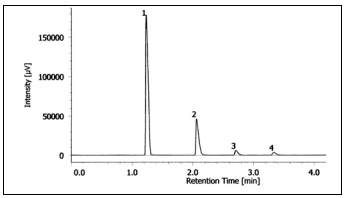
Peaks: 1 = n-hexadecane (0.600 mg), 2 = toluene (0.0245 mg), 3 = tetralin (0.163 mg), 4 = naphthalene (0.0163 mg)) Conditions: column = SFCpak SIL PA (4.6 mm ID x 250 mm L, 5µm), flow rate = 2.0 mL/min, column temperature = 35°C, temperature of FID = 350°C, back pressure = 20 MPa, injection volume = 1 µL, GC oven temperature = 200°C
Table 1. Reproducibility of retention time and peak area
| Analyte | n-hexadecane | toluene | tetralin | napthalene |
|---|---|---|---|---|
| average of retention time (min) | 1.2240 | 2.0602 | 2.7068 | 3.3290 |
| standard deviation (min) | 0.0021 | 0.0027 | 0.0032 | 0.0043 |
| relative standard deviation (%) | 0.17 | 0.13 | 0.12 | 0.13 |
| average of peak area (µV sec) | 510673 | 149556 | 21701 | 14901 |
| standard deviation (µV sec) | 6983 | 2472 | 347 | 258 |
| relative standard deviation (%) | 1.37 | 1.65 | 1.60 | 1.73 |
We evaluated the linearity of peak response by injecting 1µL each of standard mixtures with several different concentrations that were made up by diluting 2, 3 and 4 times with n-hexadecane and observed good linearity.
We injected 1 µL of commercially available diesel fuel into the system and obtained the chromatogram which is shown in Figure 3. Four repetitive injections of the fuel quantified the contents of non-aromatic hydrocarbons to be (79.77±0.12%) and aromatic hydrocarbons to be (20.23±0.12%).
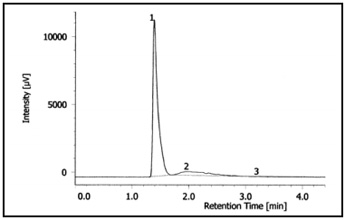
Conditions: injection volume = 1 µL. The other conditions are the same as in Figure 2.
Nonaromatic and aromatic content is 79.77 and 20.23% (standard deviation = 0.12%)
We have shown the JASCO SFC system can easily perform the analysis requirements of the ASTM with precision and accuracy.
Featured Products:

ASTM D5186 – Determination of Non-Aromatic and Aromatic Hydrocarbon in Diesel Fuels by SFC
Introduction
Application for the analysis of ASTM D5186 – Determination of Non-Aromatic and Aromatic Hydrocarbon in Diesel Fuels by SFC
This application note provides a brief overview of the analysis if diesel fuel to ASTM D5186. Diesel is a complex mixture of hydrocarbons including non-aromatic, mono-aromatic and polyaromatic hydrocarbons. It is well known that the composition of these compounds is closely related to the cetane number of the fuel, the cetane number is increased as the concentration of non-aromatics increases. As the cetane number decreases the amount of particulate matter in exhaust gas increases as the concentration of aromatics increases. The analysis of diesel fuel plays an important role in both the automobile and fuel industries.
ASTM published the Standard Test Method for Determination of the Aromatic Content and Polynuclear Aromatic Content of Diesel Fuels and Aviation Turbine Fuels By Supercritical Fluid Chromatography (D 5186 03) using a Flame Ionization Detector (FID) in 2003. This application note demonstrates that SFC with supercritical CO2 can determine the non-aromatic and aromatic contents in commercially available diesel fuel in accordance with the ASTM D5186 method.
Experimental

The SFC system we used consisted of a JASCO model PU-2080-CO2 Supercritical CO2 delivery pump, a GC-4000 Gas chromatograph with an FID (GL Science), JASCO’s CO-2060 Column oven, a BP-2080 automatic back-pressure regulator, and a JASCO AS-2059-SF autosampler with a Chromatography Data System controlling and data processing data from all of above modules. The SFCpak SIL PA column (5 µm silica gel, 4.6 mm I.D. x 250 mmL) was used for the sample separation. The column effluent was split upstream of the back-pressure regulator and a certain amount of the fluid was introduced into the FID as shown in Figure 1.

1 = bottle of liquefied carbon dioxide, 2 = pump, 3 = autosampler, 4 = heating coil, 5 = column, 6 = column oven, 7 = preheating coil, 8 = splitter, 9 = FID, 10 = oven for GC, 11 = cooling coil, 12 = back-pressure regulator.
Keywords
ASTM D5186, SFC FID, SFC-4000-FID, diesel, cetane, aromatic hydrocarbons, non-aromatic hydrocarbons, jet fuel
Results
An SFC chromatogram of the standard mixture of 1-hexadecane (0.600 mg), toluene (0.0245 mg), tetralin (0.163 mg) and naphthalene (0.0163 mg) is shown in Figure 2. Excellent resolutions (Rs), 10.56 +/- 0.04 and 6.27 +/- 0.03 were obtained in the separation between 1-hexadecane and toluene peaks, and tetralin and naphthalene peaks, respectively. Also excellent reproducibility of retention times (0.12 to 0.17% RSD, n=10) and peak areas (1.37 to 1.73% RSD, n=10) were obtained as listed in Table 1.

Peaks: 1 = n-hexadecane (0.600 mg), 2 = toluene (0.0245 mg), 3 = tetralin (0.163 mg), 4 = naphthalene (0.0163 mg)) Conditions: column = SFCpak SIL PA (4.6 mm ID x 250 mm L, 5µm), flow rate = 2.0 mL/min, column temperature = 35°C, temperature of FID = 350°C, back pressure = 20 MPa, injection volume = 1 µL, GC oven temperature = 200°C
Table 1. Reproducibility of retention time and peak area
| Analyte | n-hexadecane | toluene | tetralin | napthalene |
|---|---|---|---|---|
| average of retention time (min) | 1.2240 | 2.0602 | 2.7068 | 3.3290 |
| standard deviation (min) | 0.0021 | 0.0027 | 0.0032 | 0.0043 |
| relative standard deviation (%) | 0.17 | 0.13 | 0.12 | 0.13 |
| average of peak area (µV sec) | 510673 | 149556 | 21701 | 14901 |
| standard deviation (µV sec) | 6983 | 2472 | 347 | 258 |
| relative standard deviation (%) | 1.37 | 1.65 | 1.60 | 1.73 |
We evaluated the linearity of peak response by injecting 1µL each of standard mixtures with several different concentrations that were made up by diluting 2, 3 and 4 times with n-hexadecane and observed good linearity.
We injected 1 µL of commercially available diesel fuel into the system and obtained the chromatogram which is shown in Figure 3. Four repetitive injections of the fuel quantified the contents of non-aromatic hydrocarbons to be (79.77±0.12%) and aromatic hydrocarbons to be (20.23±0.12%).

Conditions: injection volume = 1 µL. The other conditions are the same as in Figure 2.
Nonaromatic and aromatic content is 79.77 and 20.23% (standard deviation = 0.12%)
We have shown the JASCO SFC system can easily perform the analysis requirements of the ASTM with precision and accuracy.

 Download This Application
Download This Application